When it comes to relaxation, a full body massage is one of the best ways to soothe your body and mind. But what is a full body massage? In this article, we’ll discuss the benefits and techniques of a full body massage and help you understand why it’s such a popular and beneficial form of physical therapy. We’ll also provide some tips and tricks to make sure you get the most out of your massage. So, if you’ve ever wondered “what is a full body massage?”, you’ve come to the right place!
Contents
What is a Full Body Massage?
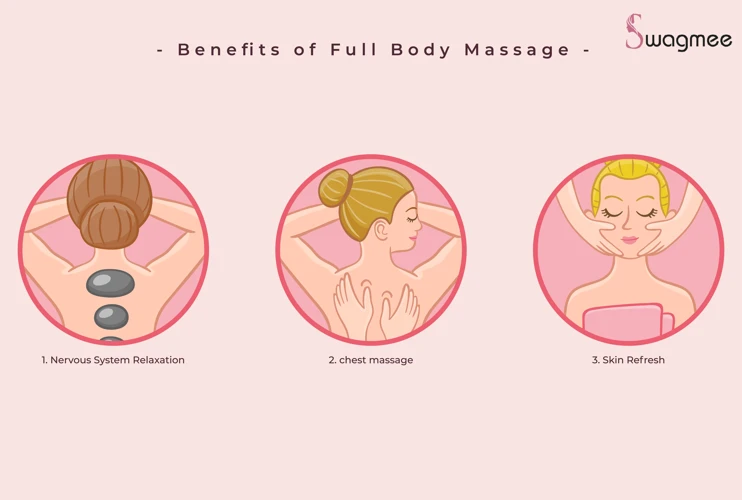
A full body massage is a therapeutic massage treatment that involves the neck, shoulders, back, arms, hands, legs, feet and sometimes even the face. It is intended to reduce tension and stress, improve circulation and promote relaxation.
Benefits of a Full Body Massage:
- Reduces muscle tension and pain
- Promotes relaxation and reduces stress
- Improves circulation and lymphatic drainage
- Aids in healing of injuries and postural imbalances
- Enhances quality of sleep
Techniques Used in a Full Body Massage:
- Effleurage – long, gliding strokes
- Petrissage – kneading, squeezing and rolling
- Friction – deep, circular movements
- Tapotement – tapping and percussive strokes
- Vibration – shaking and trembling movements
The length of a full body massage usually depends on the individual’s needs and desired outcome. Generally, the massage session can last anywhere from 30 minutes to an hour or more.
Benefits of Full Body Massage
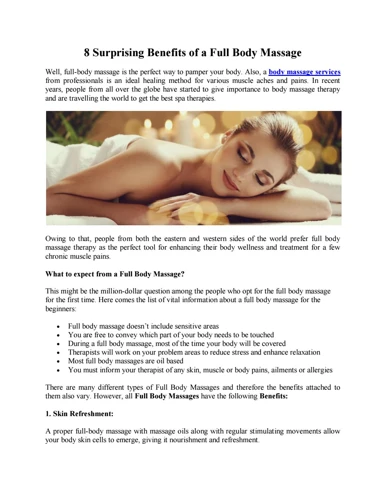
Stress Relief
A full body massage offers a unique way to reduce stress levels. It helps to relax the body and mind, encouraging a sense of calm and relaxation. Physically, massage can reduce cortisol levels, the body’s main stress hormone, leading to a decrease in anxiety and an increase in relaxation.
Improved Circulation
Full body massage can improve circulation, as it helps to open up a person’s blood vessels and capillaries, allowing more blood to flow freely throughout the body. This can help to reduce inflammation, improve blood flow, and increase oxygen levels in the body.
Pain Management
Whole body massage can be an effective tool for managing pain. Massage can help to reduce pain and tension by targeting the source of the issue. It can also help to alleviate muscle tension and spasms, which can reduce overall pain levels.
Improved Mobility
Massage can help to improve mobility and flexibility, as it helps to loosen tight muscles and connective tissues. This can help to reduce inflammation, as well as improve range of motion and reduce stiffness.
Relaxation
A full body massage can help to provide a sense of relaxation, allowing a person to feel more relaxed and at peace. Massage can help to reduce tension, as well as reduce stress levels and improve overall well-being.
A full body massage is an effective way to reap all of the benefits mentioned above. It is an effective way to relax and reduce stress, improve circulation and mobility, manage pain, and increase relaxation. What is more, a full body massage can be tailored to individual needs, ensuring that each person gets the most out of their massage experience.
How Long is a Full Body Massage?
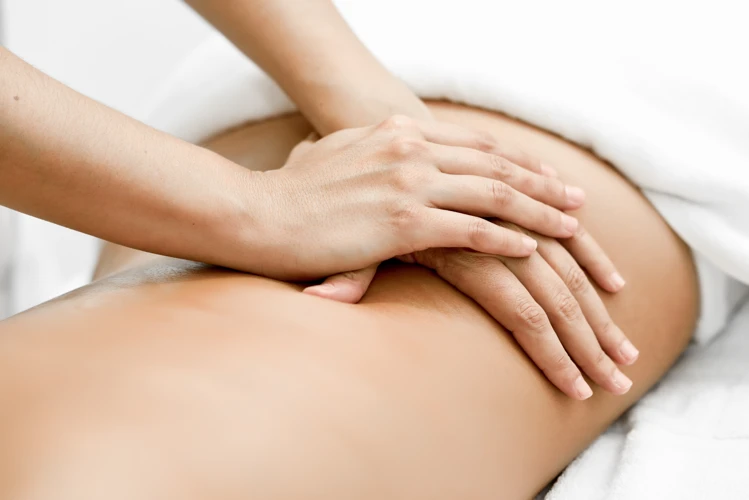
- Typically: A full body massage typically lasts between 60 to 90 minutes.
- Extended Sessions: Some massage therapies can be extended to two hours for a more detailed massage.
- Benefits of Longer Sessions: Longer massage sessions provide more time for the therapist to work on specific areas of tension and to work deeply on knots and trigger points, resulting in a more thorough massage.
- Customized Sessions: Depending on the needs of the individual, the massage therapist can customize the session to provide more time on certain areas, or to provide a full-body massage in less time.
No matter the length of the massage session, if you are looking to reap the benefits of a full body massage, you should consider booking an appointment at a licensed massage therapist. If you’re wondering where can I go to get a full body massage, you can search for the nearest massage therapist in your area.
What Does a Full Body Massage Entail?
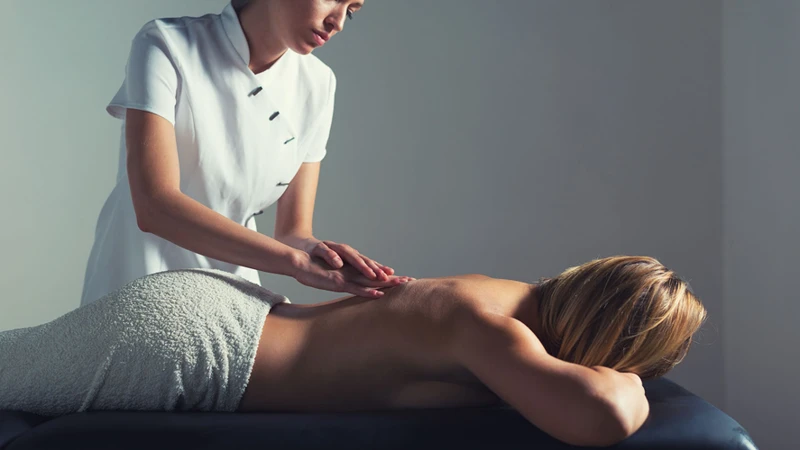
A full body massage is a therapeutic bodywork treatment that is designed to relax, revitalize, and rejuvenate the body, mind, and spirit. During a full body massage, pressure is applied to the entire body, including the head, shoulders, arms, back, abdomen, legs, and feet. This type of massage is beneficial in relieving tension, improving blood circulation, and relaxing the muscles.
Variations of Full Body Massage
Full body massages can vary depending on the type of massage being performed. Swedish massage is the most popular type of full body massage, and it typically involves gentle, long strokes to relax the muscles and promote circulation. Other types of full body massage include deep tissue massage, sports massage, and reflexology.
Pressure Applied During Full Body Massage
The amount of pressure used during a full body massage will depend on the type of massage being performed and the individual’s preferences. Generally, Swedish massage involves light to medium pressure, while deep tissue massage incorporates deeper, more intense pressure to target the deeper layers of muscle tissue. The pressure used during a sports massage is typically deeper and more focused on the areas of the body that are used the most during physical activity.
Where Can I Go to Get a Full Body Massage?
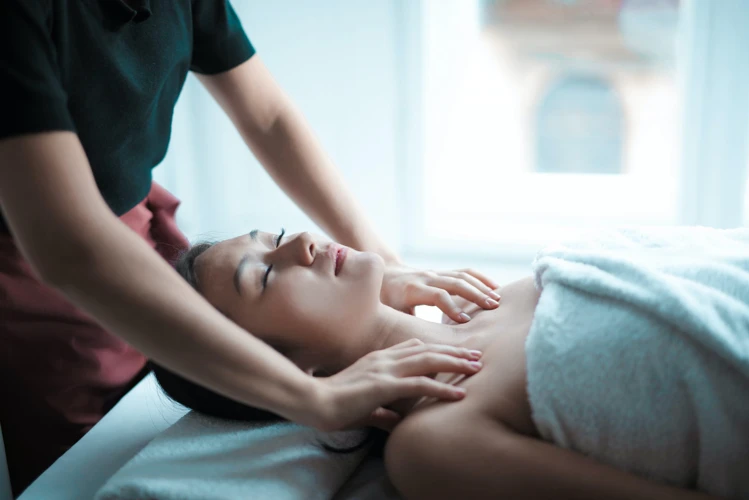
Massage Spas and Salons
- Massage spas and salons offer a variety of massage services, including full body massage, to their clients.
- You can find massage spas and salons in almost any city or town, so it’s easy to find one near you.
- You can book a massage appointment online or by phone.
At Home
- You can also get a full body massage at home. All you need is a massage table, massage oils and massage tools.
- If you are not comfortable performing the massage yourself, you can hire a professional massage therapist to come to your home.
Hotels and Resorts
- Hotels and resorts often offer full body massage services as part of their spa packages.
- These services are usually offered on-site by experienced massage therapists.
- You can book a massage appointment online or by phone.
Tips for Getting the Most Out of Your Full Body Massage
Speak to Your Massage Therapist
Before beginning your massage session, it’s important to communicate your massage goals with your massage therapist. Let your massage therapist know the areas you would like them to focus on and any areas that should be avoided. This will help your massage therapist tailor your massage to meet your needs.
Drink Plenty of Water
It’s important to stay hydrated before and after your massage. Drinking water helps to flush out toxins that are released during your massage which can help reduce soreness and improve the overall benefits of your massage.
Wear Comfortable Clothing
For a full body massage, it’s best to wear comfortable clothing that allows your massage therapist access to the areas being worked on. Loose-fitting clothing is often recommended.
Provide Feedback During the Massage
Your massage therapist wants to make sure that you are comfortable and enjoying your massage. Provide feedback during your massage about the pressure, temperature, and any areas that should be avoided or need more attention. This will help ensure that you get the most out of your massage session.
Frequently Asked Questions
What type of massage is a full body massage?
A full body massage is a type of massage therapy that involves working the entire body with massage strokes, including the back, legs, arms, abdomen, and scalp. It is typically done with the client in a prone, face-down position and can be adapted to meet the needs of the individual. The massage can be done with lotion, oil, or cream and can vary in intensity from light to deep tissue. Benefits of a full body massage include improved circulation, relaxation, and relief of muscle tension.
Are there any health benefits associated with a full body massage?
- Relieves stress – A full body massage can help alleviate stress and tension, both physically and mentally.
- Reduces pain – Massage therapy can help reduce chronic pain, such as back pain, neck pain, and headaches.
- Improves circulation – Massage can improve circulation by increasing blood flow to areas of the body that may be stiff or sore.
- Improves posture – Massage can help improve posture by loosening tight muscles and improving flexibility.
- Reduces anxiety and depression – Massage can reduce anxiety and depression by releasing endorphins, the body’s natural feel-good hormones.
- Boosts immunity – Massage can help boost the body’s immune system by improving lymphatic circulation.
What Techniques are Used During a Full Body Massage?
A full body massage typically involves using various massage techniques such as Swedish massage, deep tissue massage, trigger point massage, and sports massage. These massage techniques help to relax the muscles and improve circulation. The massage therapist may use kneading, stroking, friction, tapping, and vibration to work the muscles and improve flexibility and range of motion. The massage therapist may also use special oils or lotions to reduce friction on the skin. A full body massage usually lasts for 60 to 90 minutes and may include massage of the head, neck, shoulders, back, arms, hands, legs, and feet.
How often should I receive a full body massage?
It depends on your lifestyle and goals. Generally, it is recommended to get a full body massage once every four to six weeks. However, if you are dealing with chronic pain, you may benefit from more frequent visits. Here are some things to consider when deciding how often to book a massage:
- Your current level of stress. A massage can help reduce stress and tension, so if you are feeling particularly anxious or overwhelmed, it may be beneficial to book an appointment.
- Your lifestyle. If you have a physically demanding job or play a lot of sports, you may need to visit more often.
- Your goals. If you are hoping to address a specific issue, such as muscular tension or chronic pain, more frequent massages can be helpful.
- Your budget. Massages can be expensive, so make sure to factor in the cost when deciding how often to book an appointment.
Remember, there is no one-size-fits-all answer when it comes to how often you should receive a full body massage. Talk to your massage therapist to determine a schedule that works best for you.
Is a full body massage a good treatment for stress or anxiety?
Yes, a full body massage can be a great way to reduce stress and anxiety. The massage can help to relax the muscles, release tension, and promote the release of endorphins, which can help to reduce stress levels. Massage can also stimulate the parasympathetic nervous system, which helps to reduce heart rate, blood pressure, and cortisol levels. Additionally, massage can improve circulation, which can have a calming effect on the body.
Conclusion
A full body massage offers many physical and mental benefits. It can help to reduce stress, improve circulation, and increase flexibility. There are many techniques that can be used to give a full body massage, including Swedish, deep tissue, and reflexology. Before receiving or giving a full body massage, it is important to understand the techniques and the benefits associated with them.

